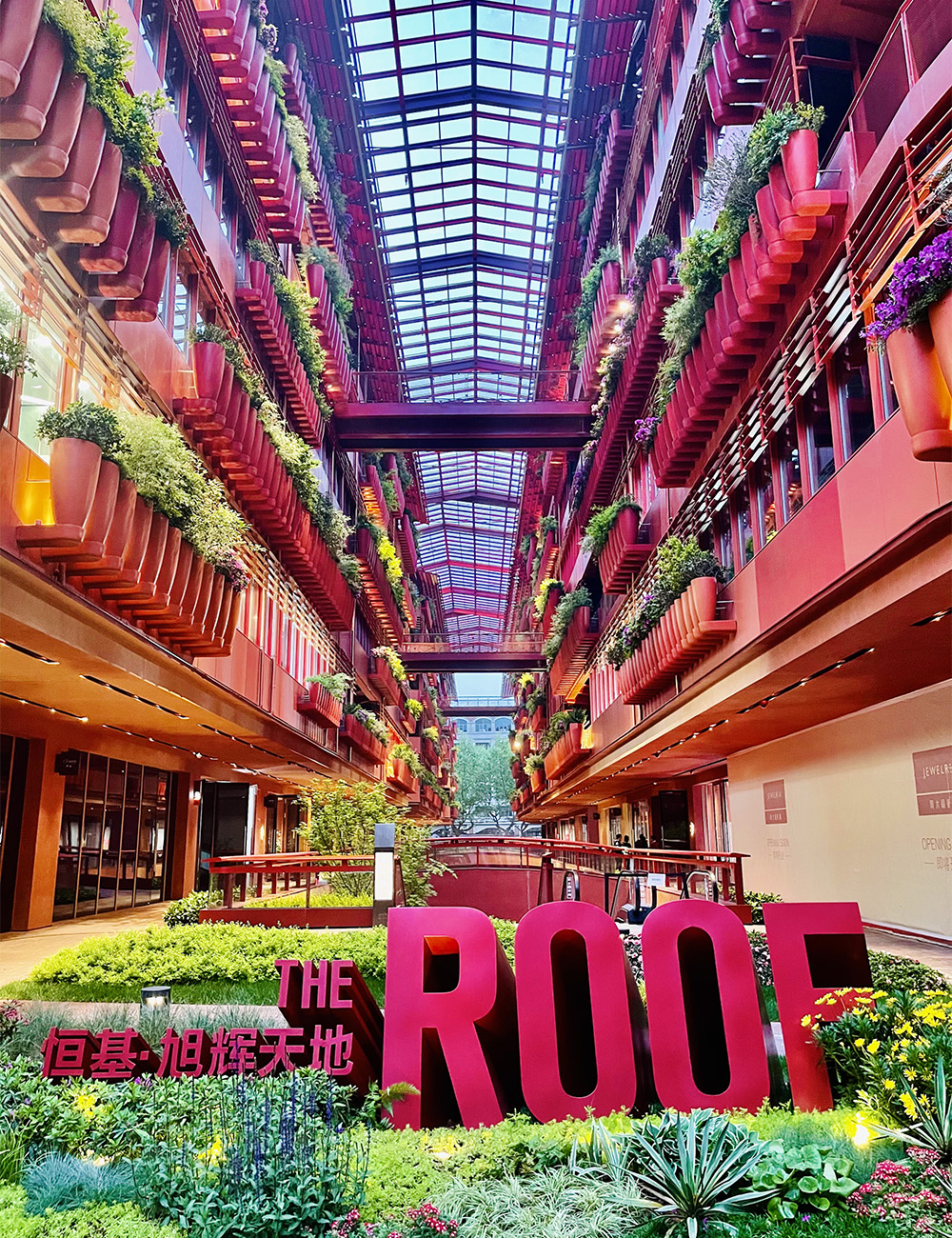






I remember the first time I saw it. The Roof (恒基·旭辉天地), aka the “Red Building” evoked a confused memory, a feeling of uncanny familiarity. On the corner of Madang Lu and Jianguo Dong Lu in Shanghai, this lifestyle hub was newly opened, yet it suggested something remote.
The Roof is an unusual, classic yet brand-new, planted-covered bit of architecture that houses restaurants, bars, cafes, boutiques, and offices.
Officially opened on May 1, 2021, this mixed-use space for offices, retail and food quickly became a landmark in the Xintiandi district in central Shanghai.
Of course, the complexity of the project and the visual impact of its red porphyry are striking, making it almost surreal.
The sophisticated international verve of the commercial activities, especially food and beverage with fusion tendencies, is also remarkable.

The Roof lifestyle hub in Xintiandi designed by French architect Jean Nouvel
In this piece, however, I will not dwell on the architectural aspects or explain its commercial offerings in detail. I am interested in capturing the essence of this place by explaining the symbolic relevance that a shopping environment like this can have in contemporary society.
So, after a stop inside the Parkview Green in Beijing as the perfect starting point for this column – The art of Chinese shopping, we keep up with our journey through the megacities and phantasmagorias of today’s country at The Roof in Shanghai.
At the time of the pandemic lockdowns, the so-called “retail apocalypse” and the “shift to the virtual realm,” The Roof allows me to reflect on the new perspectives of today’s urban experience.
Also known as the 'street of 1,000 red jars', The Roof is an interior and exterior space
The Roof’s strength lies in its ambiguity, an interior and exterior space simultaneously.
The structure looks like a mix of a traditional red brick longtang (the typical Shanghai backstreet) and a 19th-century Parisian passageway.

The Roof's structure
The street entrance invites us in as if it were a natural sidewalk extension.
But once you step inside, you get the impression of being sheltered from the weather and the annoying city traffic.
You are now drawn into this new dimension, which naturally invites people to embrace a slower pace of life.
The building offers a variation of a fairly common theme on the upper floors: we are talking about the “green wall”, which here becomes an actual indoor garden.
The plants are selected to have different shades of colour following the seasonal change.
The red-hued building Roof as an updated version of the Parisian passages
This building is undoubtedly familiar to those who are into shopping history.
This establishment is undoubtedly familiar to those who know the history and evolution of retail stores and shopping in general.
It evokes the structure of the Parisian passages that appeared in the 19th century, at the dawn of modernity, which probably inspired the French architect behind The Roof, Jean Nouvel.

Parisian covered passages inspired Jean Nouvel in creating The Roof
Initially, the passages were narrow streets between two buildings, covered by a lightweight iron and glass structure. They were places that housed luxury shops, theatres and cafes.
Passages were crucial in offering a new opportunity to use the city’s spaces. The public place became a luxury "interior" furnished and lived in by the masses.
But The Roof also adds the essential atmosphere of Shanghai's longtang, where buildings are located along several interconnected lanes.
This structure creates a private space but brings a sense of 'community' at the same time.
Don't call it a shopping mall: The creation of a 'place'
A shopping environment can only strive to become a meeting place and a living space for the community if it is integrated into the urban tissue and the city’s sociological identity.
Unfortunately, this is rare in contemporary metropolises, especially those in emerging countries affected by the gradual disappearance of public spaces.
Besides this, online shops have easily replaced physical commercial environments in recent years.
Such a situation is common when retail spaces have become, to use anthropologist Marc Augé’s definition, ‘non-places’: spaces without identity and a past, bland and disconnected from the community.
Non-places are not centres of attraction and aggregation for those who enjoy them but exist only to be used and crossed quickly for commuting or business.
The Roof seems to present a different solution: open on three sides with direct access from the street – without portals, gates and walls – it offers a charming and welcoming environment.
Actually, this mixed-use hub for offices, retail and food provides the city with more than a functional or entertainment space.
The Roof aims to be a new ‘living room’ or a ‘place’ in the anthropological meaning of this word, which can be ‘experienced’ by the urban masses.
Federico Castigliano
Post Graduate Luxury Brand Management & Marketing Lecturer, Shanghai
